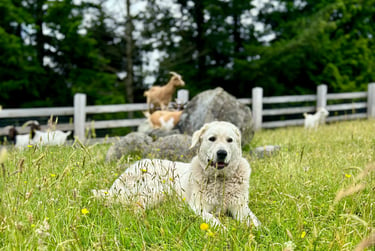Comitted to excellence in breeding hungarian Pumi and HUngarian kuvasz
Report on the Role of Kuvasz Livestock Guardian Dogs in Farm Biosecurity
Introduction
Farm biosecurity is essential for maintaining a healthy, sustainable, and productive farming operation. A significant aspect of biosecurity is preventing the introduction and spread of diseases that can be transmitted by wildlife, pests, or other external sources. Kuvasz dogs, an ancient breed of livestock guardian dogs (LGDs), have been increasingly recognized for their effectiveness in safeguarding livestock and property from such threats. These dogs are not only skilled in protecting livestock from predators but also in deterring wildlife that can carry dangerous diseases, thus playing an important role in biosecurity efforts on farms.
This report highlights how Kuvasz dogs contribute to biosecurity by preventing the entry of wildlife that could transmit diseases like Equine Protozoal Myeloencephalitis (EPM), parvovirus, Johne’s disease, Rabbit Hemorrhagic Disease (RHD), and other zoonotic or livestock-related illnesses. The report also provides an overview of the types of diseases and wildlife the Kuvasz can help keep at bay.
Kuvasz as Livestock Guardian Dogs
The Kuvasz is a large, strong, and protective dog breed originally developed to guard livestock. These dogs were traditionally used in Hungary for guarding sheep, cattle, and other farm animals, and their instincts are finely tuned to protect not only the livestock but also the property and other resources of the farm.
Kuvasz dogs are well-suited for farm environments because:
Protective Instincts: They have an inherent drive to protect and defend their territory and livestock from threats.
Physical Strength and Size: With their robust build and physical capabilities, they can deter larger predators and wild animals.
Alertness and Intelligence: Kuvasz dogs are highly alert and possess the intelligence to discern between normal farm activities and potential threats.
Independence: Unlike many working dogs that require constant supervision, Kuvasz dogs can be left to patrol independently, which makes them ideal for farm biosecurity tasks.
Role of Kuvasz Dogs in Preventing Wildlife-Related Disease Transmission
1. Equine Protozoal Myeloencephalitis (EPM)
EPM is a neurological disease that affects horses, caused by the Sarcocystis neurona protozoan parasite. This disease is transmitted through the feces of opossums, which are known to carry the parasite. Opossums are common wildlife pests that can infiltrate farms, especially in areas with abundant food sources.
Kuvasz Role: By actively patrolling the farm and preventing opossums from entering the property, Kuvasz dogs can help reduce the risk of EPM transmission. Their presence is a strong deterrent to opossums, preventing them from accessing horse stables or other areas where they may defecate, thereby limiting the chances of EPM infection.
2. Parvovirus
Canine parvovirus is a highly contagious and often fatal disease that primarily affects puppies and unvaccinated dogs. The virus is transmitted through the feces of infected dogs, and wildlife like raccoons and foxes, which are known carriers of the virus, can spread it across farms. These animals often scavenge in farm areas and potentially infect farm dogs or other animals with parvovirus.
Kuvasz Role: The Kuvasz's protective presence deters wildlife such as raccoons and foxes from entering farm properties. By keeping these animals at bay, Kuvasz dogs help reduce the potential for cross-contamination and parvovirus spread, ensuring the health of resident dogs and other animals.
3. Johne's Disease
Johne’s disease (paratuberculosis) is a chronic, contagious bacterial infection that primarily affects cattle and sheep. The bacteria that cause Johne’s disease, Mycobacterium avium subsp. paratuberculosis, can be spread by wildlife such as deer, which may infect livestock through their droppings or by sharing grazing areas.
Kuvasz Role: The Kuvasz’s natural instinct to guard livestock can also extend to ensuring that wildlife like deer do not enter pastures or grazing areas. By preventing deer from accessing the farm, the Kuvasz helps reduce the risk of Johne’s disease transmission to cattle and sheep.
4. Rabbit Hemorrhagic Disease (RHD)
Rabbit Hemorrhagic Disease (RHD) is a viral disease that affects wild and domestic rabbits. It is highly contagious and can spread rapidly through contact with infected animals or contaminated environments. RHD can cause significant losses in rabbit populations and is a concern for farms that raise rabbits.
Kuvasz Role: Wild rabbits are a common food source for larger predators such as foxes, coyotes, and bobcats, which may spread RHD on farms. Kuvasz dogs act as a barrier, preventing these predators from entering rabbit farms or areas where rabbits are raised, thus helping to mitigate the risk of RHD transmission.
5. Other Wildlife-Related Diseases
Several other diseases are carried by wildlife and can affect farm animals. Some examples include:
Leptospirosis: Carried by rodents like rats and raccoons, this bacterial infection can affect livestock and sometimes humans.
Brucellosis: Carried by wild animals such as bison and deer, this bacterial disease can be transmitted to cattle, leading to reproductive failures.
Tick-Borne Diseases: Wildlife such as deer and raccoons often carry ticks that can transmit diseases like Lyme disease and Anaplasmosis to livestock.
Rabies: Raccoons and other mammals may carry rabies and occasionally pass it to livestock.
Kuvasz Role: Kuvasz dogs can help reduce the spread of these diseases by actively keeping wildlife that carries ticks and bacteria off the farm. Their presence deters rodents, raccoons, and deer, preventing these animals from spreading diseases to livestock and other farm animals.
Additional Benefits for Farm Biosecurity
Aside from deterring wildlife and preventing disease transmission, Kuvasz dogs contribute to broader farm biosecurity efforts in the following ways:
Predator Control: Kuvasz dogs guard against larger predators like coyotes, wolves, and bears, which can pose a direct threat to livestock. By keeping these predators away, they indirectly protect the farm from potential injuries or losses due to attacks.
Alert Systems: Kuvasz dogs are known for their ability to alert farmers to any unusual activity or potential breaches of the farm’s perimeter. This makes them valuable as early warning systems for other biosecurity threats, including human intruders or trespassers who may introduce disease.
Conclusion
Kuvasz dogs are a powerful and natural tool in farm biosecurity. Their instinctual drive to protect livestock and territory makes them excellent at preventing wildlife, which can carry and spread various diseases, from infiltrating farm properties. Diseases such as EPM, parvovirus, Johne’s disease, Rabbit Hemorrhagic Disease, and others can be significantly mitigated through the presence of these guardian dogs. Beyond disease prevention, Kuvasz dogs also provide broader protection against predators, improve the overall safety of livestock, and enhance farm biosecurity efforts. For farms looking to improve their biosecurity, incorporating a Kuvasz as a livestock guardian dog can be an invaluable strategy for maintaining a healthy and disease-free environment.








Committed to Excellence
Dedicated to health and temperament in puppies.
inquiries:
szabokennel@gmail.com
© 2025. All rights reserved.
Charona Shannon
Follow Szabo Kennel on Instagram and Facebook for Updates!
